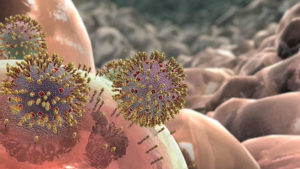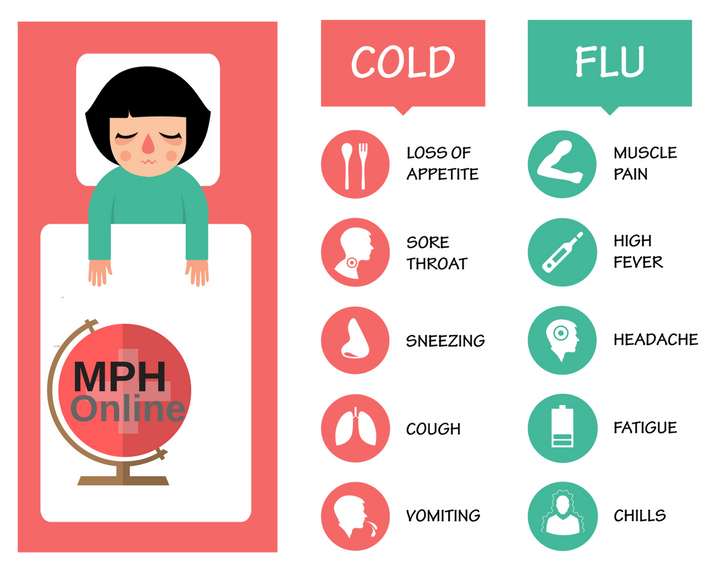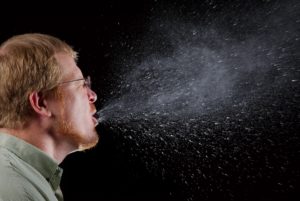It’s obvious by now that the 2017-2018 flu season is one for the record books – a full-blown epidemic that the public health system is fighting with all it’s got. It’s scary enough to have everyone asking “When does flu season end?” But epidemics like this are the reason institutions like the Centers for Disease Control (CDC) exist. The global public health system keeps track of infection rates, analyzes patterns, and educates the public about what they can do to protect themselves and others. With research, data, information, and common sense, the flu is fightable.
How Bad is the Flu?

screenshot from NPR’s Flu Attack!
This year, pretty bad. The numbers don’t lie. In the 13 years since the CDC implemented their newest, most accurate tracking system, 2017-2018 is already the most widespread and intense season yet. This season has seen the most hospitalizations for the flu in a decade: more than 7% of people seeking medical care – 1 out of every 13 people – are there just for the flu. More than 50 children have died, and for some reason the CDC has yet to pinpoint, this year has hit Baby Boomers exceptionally hard. (We won’t know how many for sure until later, since states are only required to report the deaths of minors to the CDC).
In all, 48 states are showing a serious flu problem – only Hawaii avoided a direct hit, and only Oregon has shown a decrease in infection rates since flu season started in October. That means the season not only hasn’t peaked – it might still get a lot worse. So when does flu season end? The CDC considers May the end of flu season, but viruses don’t keep calendars.
So what makes this year so bad? A few things:
The Strain: This year’s dominant strain is H3N2, causing more than three-quarters of flu cases. It’s not a new one – H3N2 is the infamous “Hong Kong flu” that became a pandemic in 1968, and it was the strain that made 2014 a rough year – but it is the most dangerous of the most common strains.
The Vaccine: Flu shot effectiveness is always an issue, but ever since the Hong Kong flu, H3N2 has been in every year’s flu shot. Unfortunately, the strain used in this year’s shot is different from the strain going around – after all, flu viruses mutate all the time. Because of the mismatch, this year’s vaccine is only showing around 10% effectiveness (by contrast, last year had a 32% success rate). Those still aren’t good enough reasons not to get the flu shot, though.
The Drugs: Antiviral drugs for flu have never been all that hot, and this year is no exception. While only 1% of flu viruses are actually resistant to the main kinds of antiviral drugs, meds like Tamiflu just don’t work unless they’re administered right away – and by then, you’ve already passed the virus on.
Should I Get a Flu Shot?
 Of course you should get a flu shot. Don’t be stupid. It would have been nice if you had gotten it back in October, since it takes 2 weeks to fully kick in, but the flu typically hangs around until May. People are always looking for reasons not to get the flu shot, especially by questioning flu shot effectiveness. But even if this year’s vaccine isn’t the most effective it could be, it’s still better than nothing – definitely, considering how many people have died and could still die (12,000 in a mild year, more than 50,000 in a bad year).
Of course you should get a flu shot. Don’t be stupid. It would have been nice if you had gotten it back in October, since it takes 2 weeks to fully kick in, but the flu typically hangs around until May. People are always looking for reasons not to get the flu shot, especially by questioning flu shot effectiveness. But even if this year’s vaccine isn’t the most effective it could be, it’s still better than nothing – definitely, considering how many people have died and could still die (12,000 in a mild year, more than 50,000 in a bad year).
Flu Shot Effectiveness (or Not)
It’s true – you may still get the flu even if you’ve been vaccinated. But flu shot effectiveness is actually about a lot more than just preventing the flu. Studies have shown that symptoms are substantially weaker for people who have had the flu shot. That means even if you get the flu, your flu will be shorter, with less risk of hospitalization and death. And that’s important – in some states, including California, Texas, and Pennsylvania, hospitals are so overrun they’ve had to resort to triage tents like you see in a natural disaster.
The vaccine is still crucial for children. After all, we’ve already seen more than 50 child deaths, and we’ve still got February, March, April, and May to go. The journal Pediatrics published the first major study of childhood flu vaccinations (from 2010 to 2014) in 2017, and it confirmed that vaccines substantially reduced infection and death. Studies show that reasons not to get the flu shot are far outnumbered by reasons you need it.
Unfortunately, if you haven’t had your vaccine yet, you may be out of luck – lots of municipalities, especially in the states with the most infections, have already reported shortages of vaccines and antiviral drugs. The CDC has actually set up a helpful Vaccine Finder online so you can find out who has the shot in your area. So stop making up reasons not to get the flu shot, and stop pretending to worry about flu shot effectiveness. If you haven’t had a flu shot, get on the app. Find Vaccines
Do I Have the Flu or a Cold?
The symptoms of this season’s flu are the same as every other year. Pretty much everyone will have some combination of:
- Cough
- Sore throat
- Runny or stuffy nose
- Muscle or body aches
- Headaches
- Fatigue (tiredness)
Surprisingly, even though we associate fever and chills with the flu, not everyone gets a fever. Besides the usual symptoms, children are much more likely than adults to get vomiting or diarrhea – in fact, in many cases, vomiting is the first symptom. Of course, kids vomit for all kinds of reasons, so if your kid is painting the walls during flu season, get them to the doctor.

Most importantly, look for the early warning signs, because catching the flu in the early stages is the only way for antivirals to work. If you’re unusually tired and feel achy for no obvious reason, it could be a bad sign – take it seriously, especially if you’ve encountered someone with the flu. (If you stayed up all night breakdancing, that’s on you).
If you have the flu, watch out for:
- very high fever that doesn’t break
- shortness of breath
- rapid heartbeat
- shallow rapid breathing
- confusion or delirium
Any of these symptoms means you need to get to the hospital. Now.
How Do I Avoid the Flu?

we can thank the CDC/Brian Judd for this disgusting sneeze image
Besides getting vaccinated – and keeping in mind everything we’ve said about flu shot effectiveness, it’s still worthwhile – there’s more you can do to prevent the flu. First and foremost, don’t be gross. Hygiene is almost the entire battle in itself. Flu germs can survive on hard objects – like doorknobs, railings, utensils, tables, coins, need we go on? – for up to 2 days. That means if someone with the flu touched that toilet handle yesterday, that flu might still be there (and plenty of other gross stuff – seriously, don’t touch the toilet with your bare hands).
Obviously, you can’t do anything about someone sneezing flu-infected snot directly in your face, but flu germs can actually live for several hours airborne – and if it’s chilly, they survive longer. They like dry air, too. So when does flu season end? If you’re smart, it’ll never start for you.
So what can you do?

There are some simple, common-sense prevention measures you can take right now.
Wash your hands. With soap and hot water. Frequently. For at least 20 seconds. “But my hands get all dried out!” you say? You know what else dries your hands out? Dying.
Clean your filthy humidifier. A lot of people use a humidifier in the winter, because winter air is drier. And a humidifier may actually help prevent flu, since flu germs like dry air (see above). But a dirty humidifier just makes things worse, since it helps spread other bacteria and molds that weaken your immune system. Then you’re back to square one – more at risk for the flu.
Clean your remote. Unless you’re a sitcom dad who protects the remote like his most prized possession, you’re not the only person touching your remote. And remotes are dirty things, with tons of little crevices perfect for hiding germs. Spray that sucker down with some disinfectant once in a while.
Below, you’ll see some of MPH Online’s must-haves for flu season. (Note: We don’t make a dime from recommending any of these products – we just think they’re great.)
3M N95 Particulate Respirator: In Japan, it’s considered polite to wear a mask if you’re sick, and the habit has spread all over Asia. Here in the US, we still look a little askance at people walking around in masks, but we shouldn’t. Whether you’re sick, or protecting yourself from germs, wearing a mask in flu season isn’t crazy: it’s smart. The N95 mask from 3M protects against 95% of particles.
Germ-X Hand Sanitizer: Washing your hands is essential, but if you can’t wash, at least kill any germs you encounter with some good old-fashioned antiseptic alcohol. There are lots of brands, and Purell tends to dominate the market, but Germ-X seems to be the better choice for those of you who are worried about drying out their skin.
Lysol Disinfectant Spray To Go: Did we mention how flu germs can live up to 48 hours on hard surfaces? A little pocket-sized spray can of Lysol Disinfectant can give you some reassurance if you’re not certain who’s been touching stuff around the office. Will everyone think you’re a germaphobe? Yeah, probably. Should you care? 48 hours, folks.
Lysol Disinfecting Wipes: While you’re at it, pick up some disinfecting wipes, too. The can might be too big to carry around in your purse, but a container in the car or in your desk is more than a little useful in flu season.
